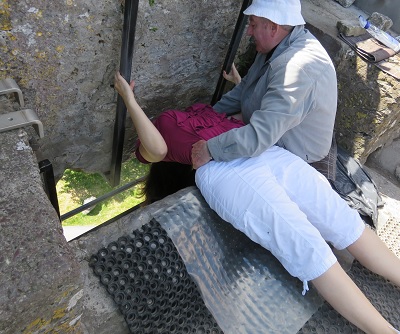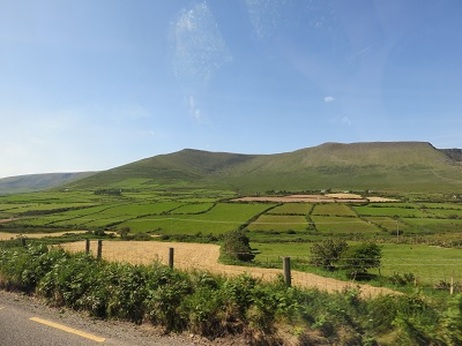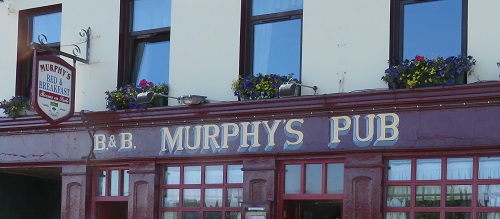Day 3:
- It’s Jacob’s pillow, brought to Ireland by the prophet Jeremiah. In Ireland it became the Lia Fáil, the Fatal Stone, used as an oracular throne of Irish kings. It later moved to Scotland, where it served as the prophetic power of royal succession and was called the Stone of Destiny.
- Or it’s a block of bluestone, the same rock used at Stonehenge. It’s half of the original Stone of Scone upon with the first King of Scotts was seated during his coronation. Robert the Bruce, King of Scots presented half of it to Cormac MacCarthy in 1314 as a gift to the Irish for supporting the Scots in the Battle of Bannockburn.
- When Cormac Laidir MacCarthy – the builder of the castle -- was involved in a lawsuit, he appealed to the Goddess Clíodhna for help. She told him to kiss the first stone he found that morning on the way to court. He did, then proceeded to plead his case with great eloquence of tongue. He won. MacCarthy then incorporated the stone into the castle’s parapet.
- Later on, during Queen Elizabeth 1’s reign, she commanded the Earl of Leicester to take possession of the castle, but whenever the Earl tried to negotiate the matter with then owner, Cormac Teige MacCarthy, MacCarthy always suggested a banquet or some other form of delay. When the queen asked for a progress report, the earl sent a long missive saying the castle remained untaken. She got so irritated that she said the report was all “blarney.”
What’s true? What’s not? I don’t know. What I do know is kissing the Blarney Stone is supposed to give you the gift of eloquent speech and the ability to deceive without offending. For a better idea of exactly what that means, they posted a sign at the castle to explain. It says,
“The difference between ‘blarney’ and ‘baloney’ is this: Baloney is when you tell a 50-year old woman that she looks 18. Blarney is when you ask a woman how old she is, because you want to know at what age women are most beautiful.”
Not bad skill to have, which is why people are willing to dangle downward from a ledge 85 feet from the ground. (Don’t worry. It sounds scarier than it is.)
The rest of the day was spent driving to Dingle, where we had to put up with scenery like this:
The only thing that annoyed me about Dingle was my boys constantly asking where they could go to pick berries. I must have been missing something because, as far as I could tell, there weren't any berry farms nearby.
Anyway, I'll have a more on Dingle in my next post but you will have to wait. Until then, it's ciao for now unless you want to stick around for another one of my cultural observations:
Irish Food
Truth be told, Ireland isn’t known for their food. I back that up. Still, there are some dishes that I found appealing. The stews -- beef and Guiness, as well as "Irish" (lamb, carrots and potatoes) – are pretty good, and my folks couldn't get enough of the mussels so I'm guessing they're pretty tasty, as well.
In an earlier post, I mentioned one of the classic Irish dishes is bacon and cabbage. Perhaps you thought that was a mistake. I meant corned beef and cabbage, right? Nope. Corned beef and cabbage is an American thing. Bacon and cabbage is Irish through and through. Keep in mind, bacon is different in Ireland. It’s still from pork, but thicker – much more akin to Canadian bacon. When the Irish came to America, they used beef as a replacement because pork was prohibitively expensive. Still, they cured or corned the beef much the same way as they did with pork in the old country.
As for potatoes, their association with Ireland is well-deserved. It’s hard to order a dish without them. At one restaurant, my husband ordered lasagna. The server asked if he wanted mashed potatoes or chips (fries) as his side dish. The upside: the potatoes are really good. So is anything dairy. The cheeses? Love them. The ice cream? Oh. My. God. If you go there you have to their whipped soft serve ice cream cones, called Irish 99s. They are highly addictive. I seriously had one every day. Here's a close up of one my father had stylishly adorned with chocolate syrup:
Luckily for my kids, the universal kids’ foods of chicken nuggets, hamburgers and pasta could be found everywhere. And the nuggets were actually made from 100% chicken, unlike whatever they’re made of in America. (Don’t tell me. I don’t want to know.)
Now with food, you often find condiments. In Ireland, the award for most used and served condiment goes to mayonnaise. It’s everywhere. Ketchup on fries? Oh no. Mayonnaise. They also like salt and vinegar, though ketchup and mustard are available, too, much to my kids relief. One evening I mistakenly ordered a Caesar salad. It’s not the same as in the States. Instead of smothering in in dressing they smothered it in – you guessed it – mayonnaise.
And, by the way, if you love soft drinks you’ll find Coke, Sprite, and Fanta a plenty. (Sorry, no root beer there.) But you're going to pay. At restaurants, a ridiculously small glass of pop will cost you 2.5-3 Euros, or about four dollars. Free refills? Not a chance.
But let’s be honest. If you’re an adult visiting Ireland you should really have its best known beverage, a Guinness beer. That is, unless you’re like me. (I'm not a beer fan.) If that's the case try a Bulmer's, a carbonated hard cider that can be found in most every pub.
And as a side note, we checked and the food at McDonald's and Burger King tastes just like the stuff in the States, only way more expensive.
So that’s the food, folks. Well, part of it. Later on I'll take you inside an Irish food store. But right now I'm going to say goodbye.












 RSS Feed
RSS Feed








